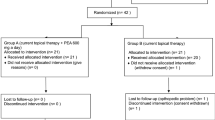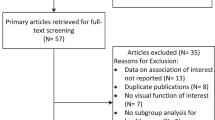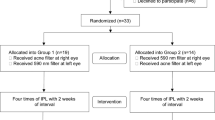Abstract
Purpose
To assess the effects of sildenafil on blue-on-yellow (B/Y) and white-on-white (W/W) Humphrey perimetry in a group of men with erectile dysfunction in 3 months regular use.
Methods
In this prospective study, 14 patients with erectile dysfunction received 50 mg doses of sildenafil (Viagra, Pfizer) two times per week regularly for 3 months. Patients underwent best-corrected visual acuity (BCVA), colour vision, anterior segment and fundus examination, and B/Y and W/W Humphrey perimetry in each eye before and after sildenafil treatment. Changes in mean deviations (MD) were compared separately for both eyes.
Results
No significant changes from baseline were observed in BCVA and colour vision after sildenafil treatment. The anterior segment and fundus examinations revealed no abnormalities. There was no change on B/Y and W/W Humphrey visual field. MD values of B/Y and W/W Humphrey perimetry remained nonsignificant for both eyes after 3 months regular use of sildenafil (P=0.133, and 0.092, respectively, for right, and P=0.221 and 0.925, respectively, for left eyes).
Conclusion
Oral sildenafil used regularly for 3 months produced no effect on B/Y and W/W Humphrey perimetry.
Similar content being viewed by others
Introduction
Sildenafil (Viagra, Pfizer) is an effective oral agent in treating erectile dysfunction. It inhibits the human cGMP-specific phosphodiesterase type 5 enzyme (PDE5) found in human corpus cavernosum.1, 2, 3, 4 Sildenafil also weakly inhibits phosphodiesterase type 6 (PDE6), that is, one-tenth of its affinity for PDE5. PDE6 is an important component of the phototransduction cascade and is present in high concentrations in cone and rod cells of the retina. Activated PDE6 hydrolyses cGMP, which reduces cGMP concentration in the outer segments of rods and cones. Reduction in cGMP concentration modulates sodium channels resulting in hyperpolarization of the photoreceptors.5, 6, 7, 8, 9, 10, 11, 12, 13 There are some reports in the literature reflecting the visual effects of sildenafil secondary to PDE6 inhibition. However, to our knowledge, there are no data on the effect of sildenafil on visual field analysis in long-term use.
This study was conducted to assess the effects of sildenafil on blue-on-yellow (B/Y) and white-on-white (W/W) Humphrey perimetry in a group of men with erectile dysfunction in 3 months regular use.
Materials and methods
A total of 14 men with erectile dysfunction were enrolled in this prospective study. Eligible patients were men older than 18 years of age who had a documented clinical diagnosis of erectile dysfunction based on clinical history, physical examination, and laboratory findings. The diagnosis was confirmed by a score of 25 or less on the international index of erectile function.14 All patients were in a stable sexual relationship. An informed consent was obtained from all subjects. The study was conducted in accordance with the tenets of the Helsinki Declaration.
All had a best-corrected visual acuity (BCVA) of 20/20 or better and normal intraocular pressure (IOP) of 21 mmHg or less. Anterior segment and fundus examinations of the patients were within the normal range. Patients were excluded if they had taken medications other than sildenafil. They were also excluded if they had eye disorders or previous ocular surgery
All patients received an oral dose of 50 mg sildenafil (given by Pfizer) two times per week regularly for 3 months. All underwent following examinations on both eyes before and after 3 months regular use of sildenafil: BCVA, colour vision (Ishihara), applanation tonometry, anterior segment, and dilated fundus examinations. The 30-2 program on the Humphrey visual field analyser (Humphrey Instruments Model 740, Carl Zeiss, USA) was used to assess visual fields. B/Y (FULLTHRESHOLD, size V stimulus) and W/W (SITA-STANDARD, size III stimulus) visual field testing was performed.
Baseline and after sildenafil treatment visual field tests were evaluated in terms of mean deviation (MD). Changes in MD were compared separately for both eyes after sildenafil treatment. The results were expressed as mean±standard deviation. Statistical analysis included a Wilcoxon rank-sum test. A P-value of less than 0.05 was considered statistically significant.
Results
Mean age of the patients was 48.5±7.2 (35–60) years. No significant changes in BCVA, colour vision, and IOP were observed after sildenafil treatment compared with baseline. None of the patients revealed any visual disturbances after sildenafil. Anterior and posterior segments examinations did not show any abnormality. There was no change on B/Y and W/W Humphrey perimetry tests. MD values of B/Y and W/W Humphrey perimetry tests remained nonsignificant for both eyes after 3 months regular use of sildenafil (P>0.05, Table 1).
Discussion
Sildenafil is a highly selective inhibitor of PDE5, responsible for the breakdown of cGMP in the corpus cavernosum.5, 15, 16 Sildenafil also weakly inhibits PDE6. The inhibition efficacy is about one-tenth of its affinity for PDE5. PDE6 is an important component of the phototransduction cascade.5, 6, 7, 8, 9
Many of the adverse effects of sildenafil may be related to the presence of PDE5 in tissues other than corpus cavernosum or to the effects of the drug on PDE6 which is present in cones and rods and plays a role in retinal light signal transduction. There are reports showing that some patients taking sildenafil have complained about increased sensitivity to light or a blue tinge to vision. Abnormal vision was dose dependent and reported by 3% of men receiving low doses of the drug (25–50 mg), 11% of men receiving 100 mg, and approximately 50% of men receiving more than 100 mg. These symptoms reach to the maximum level of 1 or 2 h after sildenafil administration and finally disappear in the 3rd or the 4th hour.4, 7, 17
Mild alternations were detected in colour vision after 100–200 mg sildenafil doses but this effect was transient.18, 19 Vobig et al20 studied electrophysiological and clinical tests after oral administration of 100 mg sildenafil and reported a decrease in the a-wave and b-wave amplitudes in the electroretinogram at 1 h after sildenafil administration, returning to normal at 6 h. They also found no effects of sildenafil on colour vision, visual acuity, and IOP. Zrenner et al21 evaluated the effect of long-term sildenafil treatment on ocular safety in patients with erectile dysfunction and found no significant changes from baseline in visual acuity, colour vision and contrast sensitivity. Our results are consistent with these reports.
The effects of sildenafil on visual field have been investigated recently. McCulley et al22 examined the effects of sildenafil on B/Y and W/W Humphrey perimetry. B/Y and W/W Humphrey perimetry tests were performed on healthy subjects before and 1 h after masked dosing of sildenafil 200 mg. Four of five sildenafil subjects had no change on Humphrey perimetry. However, one had a decrease in MD values both on B/Y and W/W Humphrey perimetry tests. Also, this subject reported more systemic side effects than other subjects. Birch et al23 evaluated the effects of a single 100 mg dose of sildenafil citrate on visual function in men with early stage age-related macular degeneration. They found that a single 100 mg dose of sildenafil produced no acute visual effects including no alternation on Humphrey visual field test or exacerbation of pre-existing visual impairment. Öner et al24 examined the effects of sildenafil citrate treatment on B/Y and W/W visual field analysis on 18 men with erectile dysfunction. All subjects (except for two who were administered 100 mg sildenafil to achieve satisfactory erection) received an oral dose of 50 mg sildenafil citrate. The visual field tests were done prior to treatment and 2 h after treatment with sildenafil citrate. They found that sildenafil causes no significant changes in Humphrey visual field analysis.
In the present study, unlike previous studies, we examined the effects of sildenafil on Humphrey perimetry in long-term use. We found that 14 of the 14 subjects had no change on W/W and B/Y Humphrey perimetry tests for both eyes after 3 months regular use of sildenafil. Also, MD values of W/W and B/Y Humphrey perimetry tests remained nonsignificant for both eyes after 3 months regular use of sildenafil.
In conclusion, this study shows that oral sildenafil in 3 months regular use seems to have no effect on the W/W and B/Y Humphrey perimetry in patients with erectile dysfunction. Further investigations are needed to clarify the effects of sildenafil on retinal function.
References
Boolell M, Gepi-Attee S, Gingell JC, Allen MJ . Sildenafil, a novel effective oral therapy for male erectile dysfunction. Br J Urol 1996; 78: 257–261.
Burnett AL . Role of nitric oxide in the physiology of erection. Biol Reprod 1995; 52: 485–489.
Terrett NK, Bell AS, Brown D, Ellis P . Sildenafil (Viagra), a potent and selective inhibitor of type 5 cGMP phosphodiesterase with utility for the treatment of zmale erectile dysfunction. Bioorg Med Chem Lett 1996; 6: 1819–1824.
Goldstein I, Lue TF, Padma-Nathan H, Rosen RC, Steers WD, Wicker PA, for the Sildenafil Study Group. Oral sildenafil in the treatment of erectile dysfunction. N Engl J Med 1998; 338: 1397–1404.
Ballard SA, Gingell CJ, Tang K, Turner LA, Price ME, Naylor AM . Effects of sildenafil on the relaxation of human corpus cavernosum tissue in vitro and on the activities of cyclic nucleotide phosphodiesterase isozymes. J Urol 1998; 159: 2164–2171.
Marmor MF, Kessler R . Sildenafil (Viagra) and ophthalmology. Surv Ophthalmol 1999; 44(2): 153–162.
Morales A, Gingell C, Collins M, Wicker PA, Osterloh IH . Clinical safety of oral sildenafil citrate (Viagra) in the treatment of erectile dysfunction. Int J Impot Res 1998; 10: 69–74.
Center for Drug Evaluation and Research. Viagra Tablets (Sildenafil Citrate): Review and Evolution of Pharmacology and Toxicology Data for NDA-20-895. Division of Cardio-renal Drug Products, Center for Drug Evaluation and Research, Food and Drug Administration: Washington, DC, 1998, pp 19–21.
Center for Drug Evaluation and Research. Animal pharmacology: mechanism of action, section 4.2. In: Viagra (sildenafil): Joint Clinical Review for NDA-20-895. Center for Drug Evaluation and Research, Food and Drug Administration: Washington, DC, 1998, p 4.
Beavo JA . Cyclic nucleotide phophodiesterases: functional implications of multiple isoforms. Physiol Rev 1995; 75: 725–748.
Luu JK, Chappelow AV, McCulley TJ, Marmor MF . Acute effects of sildenafil on the electroretinogram and multifocal electroretinogram. Am J Ophthalmol 2001; 132: 388–394.
Behn D, Potter MJ . Sildenafil-mediated reduction in retinal function in heterozygous mice lacking the gamma-subunit of phosphodiesterase. Invest Ophthalmol Vis Sci 2001; 42: 523–527.
Gonzalez CM, Bervig T, Podlasek C, Huang CF, McKenna KE, McVary KT . Sildenafil causes a dose- and time-dependent downregulation of phosphodiesterase type 6 expression in the rat retina. Int J Impot Res 1999; 11: 9–14.
Rosen RC, Riley A, Wagner G, Osterloh IH, Kirkpatrick J, Mishra A . The international index of erectile function (IIEF): a multidimensional scale for assessment of erectile dysfunction. Urology 1997; 49(6): 822–830.
Moreland RB, Goldstein I, Traish A . Sildenafil, a novel inhibitor of phosphodiesterase type 5 human corpus cavernosum smooth muscle cells. Life Sci 1998; 62: 309–318.
Boolell M, Allen MJ, Ballard SA, Gepi-Attee S, Muirhead GJ, Naylor AM et al. Sildenafil: an orally type 5 cyclic GMP-spesific phosphodiesterase inhibitor for the treatment of penile erectile dysfunction. Int J Impot Res 1996; 8: 47–52.
Center for Drug Evaluation and Research. Phase I investigator-blind, placebo-controlled, evaluation of safety, toleration and pharmacokinetics of sildenafil following escalating single oral doses in healthy male volunteers: Study 148-004. In: Viagra(R) (sildenafil): Joint Clinical Review for NDA-20-895. Center for Drug Evaluation and Research. Food and Drug Administration: Washington, 1998, pp 96–98.
Center for Drug Evaluation and Research. A double-blind, randomised, placebo-controlled, four-period crossover study to assess the effect of orally administered sildenafil (50, 100, and 200 mg) on visual function in healthy male volunteers. Study 148–223. In: Viagra (sildenafil): Joint Clinical Review for NDA-20-895. Center for Drug Evaluation and Research. Food and Drug Administration: Washington, 1998, pp 160–161.
Center for Drug Evaluation and Research. A Double-blind, randomised, placebo-controlled, four-period crossover pilot study to investigate the effects of a single oral tablet dose of sildenafil (200 mg) on visual function (electroretinogram, photostress, visual field and colour discrimination tests) in healthy male volunteers and patients with diabetic retinopathy. Study 148–232. In: Viagra (sildenafil): Joint Clinical Review for NDA-20-895. Center for Drug Evaluation and Research. Food and Drug Administration: Washington, 1998, pp 177–178.
Vobig MA, Klotz T, Staak M, Bartz-Schmidt KU, Engelmann U, Walter P . Retinal side effects of sildenafil. Lancet 1999; 353: 375.
Zrenner E, Koppiker NP, Smith MD, Constable I, Littlewood R, Stuckey B . The effects of long-term sildenafil treatment on ocular safety in patients with erectile dysfunction. Invest Ophthalmol Vis Sci 2000; 41: S592.
McCulley TJ, Lam BL, Marmor MF, Hoffman KB, Luu JK, Feuer WJ . Acute effects of sildenafil (Viagra) on blue-on-yellow and white-on-white Humphrey perimetry. J Neuroophthalmol 2000; 20: 227–228.
Birch DG, Toler SM, Swanson WH, Fish GE, Laties AM . A double-blind placebo-controlled evaluation of the acute effects of sildenafil citrate (Viagra) on visual function in subjects with early-stage age-related macular degeneration. Am J Ophthalmol 2002; 133: 665–672.
Öner HF, Aslan G, Kurtulan E, Uçar T, Saatçi OA, Esen AA . Effect of sildenafil citrate on retinal functions: Preliminary report on Humphrey visual field analysis. Urol Int 2004; 73: 28–30.
Author information
Authors and Affiliations
Corresponding author
Additional information
The authors have no financial interest with any of the material used in this study
Rights and permissions
About this article
Cite this article
Dündar, S., Topaloǧlu, A., Dündar, M. et al. Effects of sildenafil on blue-on-yellow and white-on-white Humphrey perimetry in 3 months regular use. Eye 20, 810–813 (2006). https://doi.org/10.1038/sj.eye.6702017
Received:
Accepted:
Published:
Issue Date:
DOI: https://doi.org/10.1038/sj.eye.6702017
Keywords
This article is cited by
-
Response to Tomsak, R. PDE5 inhibitors and permanent visual loss (Int J Impot Res 2005; 17: 547–549)
International Journal of Impotence Research (2006)



